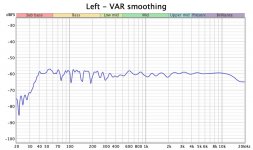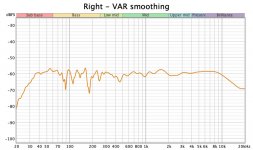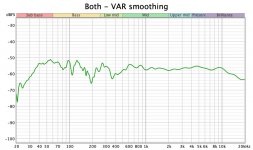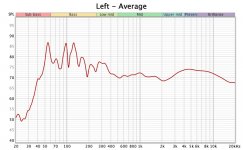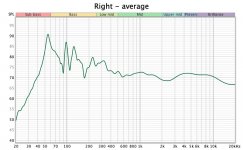That has a look of boundary interference to it. Have you got the measurements of what the response was before you EQ'd it? Have you tried to measure from different positions left to right?
That has a look of boundary interference to it. Have you got the measurements of what the response was before you EQ'd it? Have you tried to measure from different positions left to right?
Many thanks. Here are the left and right pre-EQ responses. I'm afraid I don't have one for both speakers together. Each of these is an average of three sweeps. One at the listening position, one approx 50cm to the right and one approx 50cm to the left.
Attachments
Looking at the different positions separately can help to identify where the issues are developing. Averaging the curves together hides the real problem.
You can get a good idea of the combined response by vector averaging the left and right impulses in REW after they are time aligned.
If you have the measurements in one REW project you can zip the mdat and attach it to a post if it isn't too big.
I wonder if the 2k dip is related to directivity mismatch and by filling it there will end up being a peak in the on axis response. This is the difficulty in trying to EQ speakers in a room when you don't have anechoic or semi anechoic response data for them.
You can get a good idea of the combined response by vector averaging the left and right impulses in REW after they are time aligned.
If you have the measurements in one REW project you can zip the mdat and attach it to a post if it isn't too big.
I wonder if the 2k dip is related to directivity mismatch and by filling it there will end up being a peak in the on axis response. This is the difficulty in trying to EQ speakers in a room when you don't have anechoic or semi anechoic response data for them.
Batch filter creation
Is there any way to batch create a set of filters ?
One filter for each sample rate in a specified range [min, max] ?
Thanks much.
Is there any way to batch create a set of filters ?
One filter for each sample rate in a specified range [min, max] ?
Thanks much.
That is not possible unfortunately.
Note that the number of taps has to be increased proportionally to the sample rate to get the same result. Same goes for the centering value if it is defined as a number of samples.
Note that the number of taps has to be increased proportionally to the sample rate to get the same result. Same goes for the centering value if it is defined as a number of samples.
Thanks for the info and quick response.
I haven't ventured off the default [middle/use closest perfect impulse] centering.
I haven't ventured off the default [middle/use closest perfect impulse] centering.
That is not possible unfortunately.
Note that the number of taps has to be increased proportionally to the sample rate to get the same result. Same goes for the centering value if it is defined as a number of samples.
Dear Tom, you have been suggesting not to eq phase for high frequencies. It's also thought to cause ringing to phase eq below 100Hz. So what would you say is the frequency range one should comfortably eq phase?
Thanks for the info and quick response.
I haven't ventured off the default [middle/use closest perfect impulse] centering.
When I first started pOs got me going on things and
He helped me the most to make good sounding filters
With low taps (like a 2x4hd) I usually use a rectangle window and align center unless I’m under about 400hz then I start centering in ms
I’ll type like 10ms for a 80hz crossover (lr4) with 1024 taps at 95k rectangle window and it works good enough to use. But for like 120hz you could try alignment at 8md or so depends on your filter requirements.
But using ms helps me a lot and as long as the red and blue are not completely wiggles and waves and follows the blue for the most part it will sound good
I pretty much only use rectangle windows as of now.... they sound good and I’m not cutting anything off because of my lack of knowledge
Last edited:
I eq phase when the wavelength is larger than the size of my HF driver piston
And everywhere that is not minimum phase
Low frequencies in my room are purely minimum phase under the 1st comb filter for me is 96hz so everything above is fair game to me
That’s how I do it at least idk about anyone else
And everywhere that is not minimum phase
Low frequencies in my room are purely minimum phase under the 1st comb filter for me is 96hz so everything above is fair game to me
That’s how I do it at least idk about anyone else
Last edited:
Look at excess GD to be certain is always recommend I would actually say being this thread became crickets ......
(Someone talk to me) I feel a little alone on my comments lol (kidding)
(Someone talk to me) I feel a little alone on my comments lol (kidding)
Thanks for the explanation. I wanted to make sure the filters were constructing filters properly.
My decade old music PC can just barely run 8 x 256K tap / 192KHz filters which maxes out my 8 channel DAC's inputs.
I am budgeting for a new music PC next year when the new chipsets come out. Intel is supposed to be coming out with PCIe5, DDR5 and 10nm. Getting into NVMe drives won't hurt either.
Hi POS! I was wondering what do you use to host your filters?
I eq phase when the wavelength is larger than the size of my HF driver piston
And everywhere that is not minimum phase
Low frequencies in my room are purely minimum phase under the 1st comb filter for me is 96hz so everything above is fair game to me
That’s how I do it at least idk about anyone else
Yes, linearizing the phase of coherent crossovers is a no brainer, regardless of the frequency (as long as the crossover is indeed coherent over a respectable angle, which can be tricky at higher frequencies).
The high pass and low pass of the system is a different story, with measurable pre ringing.
I am currently using a pair of openDRC-DI for a pair of active 2-ways.Hi POS! I was wondering what do you use to host your filters?
6144 taps at 48kHz is not enough to tackle LF EQs with moderate to high Q, but the openDRC also has a bunch of available biquads that can do the job.
The high pass and low pass of the system is a different story, with measurable pre ringing.
Hi Pos,
What do you do for best practice on the ends, particularly high pass?
I've never had much need for system low pass other than to clean up measurement gack ripples, and then I've found a variable Q IIR, about 0.4BW at about 17kHz to work best. But any advice on this end welcome too.
Thanks 🙂
I generally don't linearize the phase of the high pass because it implies too many taps and too much delay for my typical use cases.
I generally don't linearize the phase of the high pass because it implies too many taps and too much delay for my typical use cases.
Too many taps? On the high pass? ......
I get the delay issue if can’t sync with home theatre, but for us who don’t have video or live stuff....
Like I’m using linear phase crossovers on everything, with a short fir at each output in a 4 way then a DI upstream and I removed the excess GD that was from about 1.6k to 120 (witch reaches to about 90hz because I’m centered at 120) and anything with high Q I left alone , only stuff under a Q=2 or
Or less I use phase eq.
I’m not seeing much for pre ring, and my overall offset is only 58ms
Does that seem correct to you?
I meant too many taps for my use case *and device*, which is an openDRC.
I already have to use biquads for some EQ points down low, so linearizing the phase of the HP would be pushing it.
I already have to use biquads for some EQ points down low, so linearizing the phase of the HP would be pushing it.
I meant too many taps for my use case *and device*, which is an openDRC.
I already have to use biquads for some EQ points down low, so linearizing the phase of the HP would be pushing it.
What would you do for a system HP if openDRC had 16k taps? (at 48kHz).
Linearize or not, and if linearize, linearize exactly what?
Or say even 65k taps, ala PC?
My interest here is purely in terms of avoiding pre-ringing, and unnatural corrections.
Your vision on this has to be much deeper than mine 🙂
Last edited:
This is interesting indeed I’ve been think about it all day
So..... what about this logic is it right or wrong
When it comes to HF
When the magnitude is +/- 2db and whatever frequencies are within 360 degrees it’s fair game.....
Frequencies that are more then +/- 360 deg something else needs to be done
Like signal delay or addressing install issues or placement issues or power issues like levels etc etc
And when 1db differences in HF is like hundreds of degrees of phase do something else
Is that right or wrong ?
So..... what about this logic is it right or wrong
When it comes to HF
When the magnitude is +/- 2db and whatever frequencies are within 360 degrees it’s fair game.....
Frequencies that are more then +/- 360 deg something else needs to be done
Like signal delay or addressing install issues or placement issues or power issues like levels etc etc
And when 1db differences in HF is like hundreds of degrees of phase do something else
Is that right or wrong ?
- Home
- Design & Build
- Software Tools
- rePhase, a loudspeaker phase linearization, EQ and FIR filtering tool
